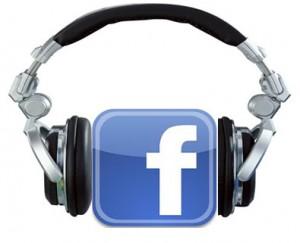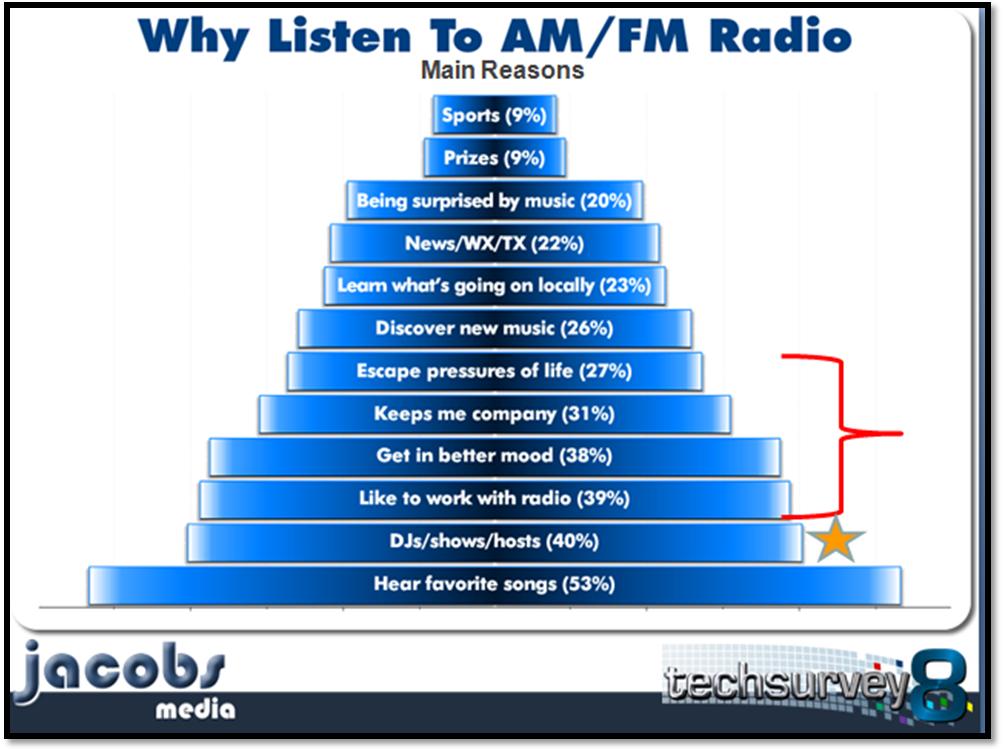You probably saw all the confetti raining down from the sky after the release last week of that Annenberg School study confirming that radio listeners bond with their favorite DJs. Put together by Paula Woodley, this study surveyed listeners from seven L.A. radio stations, and confirmed that the “stickiness” of radio brands comes from personalities rather than music. Bought and paid for by Katz, it’s a very positive study for radio that reinforces much of what we saw in Techsurvey8.
In our nationwide study, being connected to DJs, shows, or personalities is the #2 driver that explains why consumers love radio. And what followed were those four emotional triggers – at work listening, mood elevation, companionship, and escape – that fill in the picture of broadcast radio’s appeal.
The Annenberg study and Techsurvey8 also explain radio’s key advantages over pure-plays. Our questions about Pandora’s weaknesses produced two key negatives that should be the “secret sauce” for radio brands – the connection with people on the air and being in touch with what’s happening around them. These are the proprietary elements that give radio distinct advantages over other digital audio channels.
But if you read deeper, there’s more to the Annenberg research because it provides an additional ingredient that should be a part of the radio success story. Seven of every ten of their respondents say they follow a favorite radio personality on social media channels. For half of those consumers, the benefit is “to make them feel like they know the personality better.”
So not only are personalities at the core of the radio listening experience, but their social interaction with the listeners who love them turbo-charges those relationships.
But here’s the dirty little secret…
Most of the DJs at these seven L.A. stations – as well as most personalities around the country – do little to connect and interact with these fans on social media sites. Imagine how much stronger these numbers might have been if more radio DJs, hosts, and shows were engaged in genuine dialogue with these fans.
The truth is, some are simply unqualified to effectively connect using these tools. Others stubbornly refuse to buy in to these new relationship-building channels. And still others are willing, but lack the training necessary to step up their games and communicate with audiences socially. Sadly, many broadcasters aren’t investing in the education and hands-on guidance that could facilitate better social interaction, and thus, a great feeling of loyalty.
While some jocks – especially those who have been around for decades – shy away from personal appearances and hanging out with listeners, the ability to make eye contact socially on Facebook, Twitter, and other channels is relatively simple – and incredibly effective.
The verbatim comments from the Annenberg study reinforce this notion:
“You get a sense of how real a person they are and you can relate to them as well.”
“Yet, it makes them seem real and you know them on a personal level.”
“I get to see the activities and products they do.”
“Kinda makes you get to know them a little better.”
“Because he actually replies to you and makes you feel important.”
This last comment is the exception, but it underscores the importance of a dialogue with listeners, and the power of acknowledgment.
 For the first time in radio’s history, personalities have the ability to take the audience behind the scenes and into their lives. This is a powerful force that only serves to galvanize the relationship between them and their listeners. And when you feel like you know a personality, you listen more often.
For the first time in radio’s history, personalities have the ability to take the audience behind the scenes and into their lives. This is a powerful force that only serves to galvanize the relationship between them and their listeners. And when you feel like you know a personality, you listen more often.
Our Lori Lewis has been on a mission to help DJs and hosts better understand the power of nurturing relationships – not just to more effectively compete against a Pandora but to truly take the listener-DJ connection to the next level.
After another trip to the Morning Show Boot Camp last month, I continue to believe that many personalities are looking for direction from their companies.
While the DJ/owner relationship sometimes is strained or even adversarial, the two sides are most definitely in it together when it comes to making radio a stronger and more viable medium. The need to educate the airstaff is part of ownership’s responsibility. So is an open mind and a willingness to learn “new tricks” from the air studio side of the spectrum.
After reading the Annenberg study and reviewing our own study covering 12 formats, here are my questions for broadcasters:
- Are you effectively communicating the value of social interactivity and audience connectivity to your personalities?
- Do your company, cluster, and individual station brands have a viable social strategy that everyone on the team understands?
- Are you working with airstaffs to ensure their messaging and acknowledgment are on-point and timely?
- Are you providing the education and the tools they need in order to learn these new skills?
- Are you redefining your company’s criteria for future hires to better reflect these values?
At a time when many hometown DJs are being cast aside, here’s a study from a respected university and Katz Radio that urges radio to rethink the trend to simply jettison jocks and pipe in Ryan Seacrest. And the research clearly underscores the value of social media to enhance listener loyalty and brand equity.
Katz, the Annenberg School, our company, and others are helping to light the path that can help radio succeed in this new digital world.
If you are an owner or manager reading this post, take an objective look at the social interactivity your stations and personalities are creating. If you don’t know how to use the available metrics to evaluate your stations, learn how or get some help. Ratings and revenue are no longer the sole measure of success, especially in the digital world (the one your audience lives in).
It’s time to walk that walk and invest in personalities and the essential training and education necessary in order to optimize these social and digital tools.
- Media And Technology In 2025: Believe It Or Not! - April 18, 2025
- In Radio, You Just Never Know - April 17, 2025
- The Secret To Making A Great Podcast (And Great Radio) - April 16, 2025





Tremendous post, but it overlooks one of the key issues in training DJ’s to be social media superstars. The people who supervise/manage the DJ’s don’t have the understanding or skills to fully understand social media, so how in the world can you expect them to train their Boss Jox to use social media? Owners and managers need to know social media, but their PD’s REALLY need to know how it works, and very few do.
And how can we expect people tracking a pile of markets to try to connect locally?
Mark, no question that in many cases, this social media special ed needs to be station wide. That was Lori’s mission with Midwest Communications, and it’s the attack plan at Jacobs Media. We work with great content creators in radio, but different channels demand different treatment and sensitivity. Thanks for the comment and the perspective.
I agree Mark Edwards. It’s my job at Lotus Reno to train DJs and other staff how to navigate and participate with our social media platform. The skill level various from programmer level to some who don’t even own computers at home. You have to be patient and understand everyone is coming from a different background.
Another challenge is the age old friction between sales and programming. Sales wants to sell it, Programming wants to keep it and no one really knows what to really do with it. I find that if you keep it about quality content… something actually useful to the listener then you are on the right track. The user experience should be top priority when thinking about how to layout your website / social media plan. Well at least in my opinion… 🙂
Fred or Lori do you agree?
~Layla James
Fred here, and I think you’re right on track. I’ll make sure Lori gives you her 2-cents, too. Thanks, Layla.
You’re right on, Layla. The reason a cohesive vision is needed digitally and socially is just what you said. “Sales wants to sell it, Programming wants to keep it.”
The worlds can coexist when everyone has perspective on how each platform works and why fans use it.